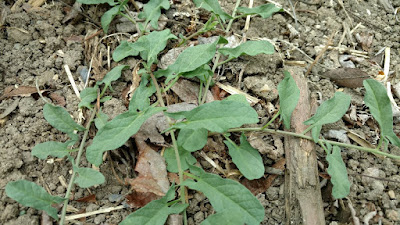
|
|
Pretty flowers? More like the stuff of a gardener's nightmares. It's bindwind, and it's awful. (Photo:
Kathy Morrison)
|
Bindweed grows rapidly, needs ‘incessant vigilance’
With arrow-shaped leaves and trumpet-like flowers, this vine looks innocent, even pretty. But watch out; it’s a strangler. And right now, bindweed has intentions of taking over your garden.
For a century, bindweed has ranked as California’s worst weed. We’re not alone; it’s considered a serious or problem weed in at least 33 countries.
But its reputation goes back much, much longer. The ancient Greeks complained about it in 100 A.D.
A historical glance at bindweed shows just how tenacious and troublesome this plant can be. Native to Eurasia, bindweed was called periklumenon or “circling plant” by the Greeks. The Romans had a more descriptive name,
volucrum majus
, which means “large worm that wraps itself in vines.”
By the 1500s, bindweed had a bad rap all over Europe. Besides bindweed, it’s known as devil's guts, creeping Jenny, hedge bells, corn lily, withwind, bellbine, laplove, sheepbine, corn-bind, bearbind, possession vine and, of course, morning glory (its ornamental close cousin).

|
These are the familiar and distinctive leaves of this fast-growing
weed. (Photo: Debbie Arrington).
|
Bindweed (
Convolvulus arvensis
) made it to North America more than 300 years ago, most likely in grain seed. By 1739, Virginia farmers were fighting bindweed in their fields. By the birth of our nation, bindweed could be found in all 13 colonies.
During the early days of the Civil War, Pennsylvania botanist and Congressman William Darlington compared fighting for the rights of free men like controlling bindweed; it required “incessant vigilance.”
Bindweed came west with settlers.Planting contaminated wheat seed, Ukrainian settlers were blamed for the Great Plains’ “bindweed plague” of 1877. Not only do bindweed vines strangle wheat plants, bindweed seeds add unpleasant flavors to wheat flour.
Every bindweed in the Northwest can be traced to an Oregon settler who mistakenly planted bindweed as a cover crop for his orchard. According to the University of California, bindweed was first reported in San Diego in 1884. But other research shows its presence in the Bay Area as early as 1838.
California farmers have been officially warring with bindweed since the 1920s. Yet, bindweed just keeps coming.
Why is bindweed so resilient and tough to eradicate? It’s a survivor.
Bindweed is a hardy perennial, meaning the top may die back, but the rhizomes will send out new shoots as needed. Its roots can reach 20 feet deep. It also sends out lateral roots several feet in each direction. Those laterals send down vertical roots and start new plants. One plant can spread 10 feet in every direction in just one season.
That massive root system is key to its drought resistance – and why bindweed is so difficult to control. UC research found that 1 acre of bindweed can produce 5 tons of roots and rhizome. Every 2-inch fragment of root or rhizome is capable of producing another plant.
And then there are the seeds; on average, 550 per plant. Those seeds can stay viable in the soil for 60 years! Digging up soil to get rid of bindweed roots can bring long-dormant seeds to the surface to sprout.
How to control bindweed? Be just as persistent. Pull seedlings as soon as they appear. The seedlings form a perennial rhizome after three or four weeks (and will be much harder to eliminate).

|
|
If you see flowers, get rid of them before they set
seed. These are growing in a patch of jasmine.
(Photo: Debbie Arrington)
|
If you see flowers, definitely pull those plants before they set seed, further compounding problems.
When weeding, use a hoe and whack the plant about an inch below the plant’s crown. That leaves the weed’s roots and seeds below soil level. Repeat every two to three weeks as the roots resprout. Eventually, the plant is deprived of energy and starts to give up.
Landscape fabric or cardboard topped by mulch can eventually suffocate bindweed. It deprives the plant of light and energy and will kill the roots, too – after about three years. But bindweed is very opportunistic; it will work its way through any hole in the fabric or opening in the mulch.
As for chemical controls, Roundup (glyphosate) can slow bindweed down. To be most effective, the herbicide needs to be hand-painted onto the vine’s leaves, then takes about three weeks to kill the vine. But the herbicide can damage shrubs (especially roses) or other nearby plants, so use precautions such as shielding them from possible exposure.
For more information on bindweed and possible control, check out the UC Integrated Pest Management tips at
http://ipm.ucanr.edu/PMG/PESTNOTES/pn7462.html
.
(Confidential to our loyal readers: Today is the 2nd anniversary of Sacramento Digs Gardening! Thanks for reading, commenting and sharing our work.)



